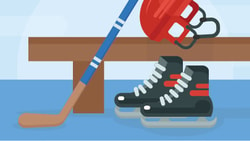Ice Hockey Injuries: Who Gets Hurt and When Does it Happen?
November 21, 2016
3 min. read

This is part one of aseries on ice hockey injuries that will cover how and why injuries occur, as well as risk assessment and prevention.
Ice hockey is an inherently physical sport and as such creates situations where injury is possible, and often likely. Considering the influence injuries can have on a team's success, research has started to focus on our ability to assess injury risk and prevent injuries before they occur. However, these strategies cannot be effectively laid out until we first understand who gets hurt, when they get hurt, and how they get hurt.
Who Gets Hurt?
Injury incidence varies greatly depending upon player position in NCAA DivisionI ice hockey. Goaltenders experience the fewest injuries followed by defensemen and forwards (see the table below).
| Injury Incidence in NCAA Division I Ice Hockey | ||
|---|---|---|
| Position | % Injuries(Flik et al.) | % Injuries (Agel et al.) |
| Goaltender | 6.2 | 9.6 |
| Defensemen | 32.7 | 40.8 |
| Forward | 61.1 | 48.3 |
This information correlates with a recent study investigating injury incidence during the World Championship and Olympic tournaments.9
In the National Hockey League (NHL), findings were different:
Defensemen were significantly more likely to miss game time due to injury compared to forwards.3
Being a goaltender also increased the odds of missing at least 5 games due to injury (odds ratio = 1.68). Though goaltenders are seldom injured, they take longer to return to play.3
These numbers are likely not as drastically position dependent due to the disparity of position players on the ice at one time (3 forwards, 2 defensemen, and 1 goaltender). This may account for the variance reported in the literature at the collegiate, international, and professional levels.
When Do They Get Hurt?
Understanding when injuries occur during a game and throughout the course of the season allows us to understand when an athlete's risk of injury increases.
At the collegiate level, 65.5% of injuries occur during games and 35.5% during practice. Also, injury rates in preseason practice were double that in-season.2
Two studies looked into the distribution of injuries during game play and found drastically different results:
In the NCAA, most injuries occurred in the 2nd and 3rd periods.1 Likely explanation is athletefatigueand gameplay intensity increasing as the game progresses.
In the NHL, in contrast to the above, the vast majority of regular season injuries occur in the first period (48.1%).3Intuitively, as the NHL season progresses, injuries become more likely. The high injury rate is likely due to player fatigue and increased intensity of play as teams fight for a playoff spot.
Now that we know who gets injured and when these injuries occur most often, we can begin taking the necessary steps to evaluating injury risk. The second article in this series on ice hockey injuries will focus on how athletes are hurt and why this matters in the management of this population.
Below, watch Todd Arnold discuss goal and risk identification in pre-participation evaluations in a short video from his and Phil Plisky's course, Pre-Participation Evaluation: Medical and Musculoskeletal.






